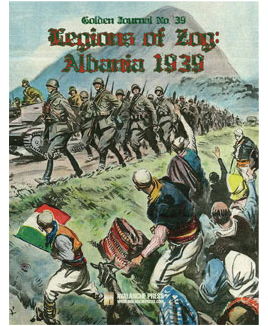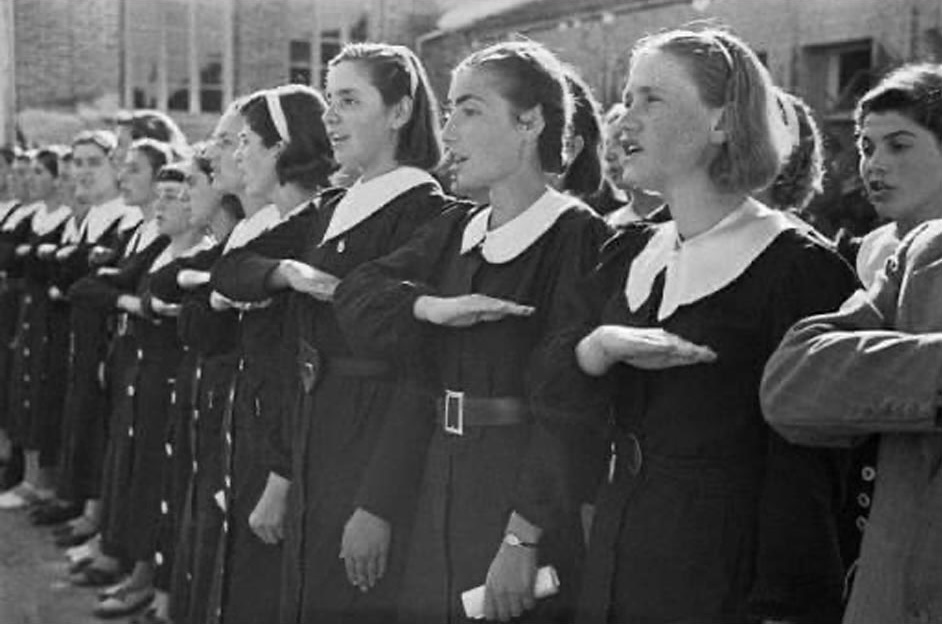| Golden Journal No. 39:
Legions of Zog
Story of Albania, Part Three
by Mike Bennighof, Ph.D.
March 2022
 In 1911, at the age of 16, Ahmed Zogu, born Ahment Zogolli, had succeeded his father as governor of Mati, a region in north-central Albania. Still a teenager, he led Mati’s tough tribesmen into war with the Montenegrins, and afterwards become deeply involved in the politics of Albanian independence. During the Great War, he enlisted in Austria-Hungary’s Albanian Legion along with several hundred of his followers, but his pro-independence activities got him sent to Vienna with instructions to visit cafés and stay out of Albanian politics. In 1911, at the age of 16, Ahmed Zogu, born Ahment Zogolli, had succeeded his father as governor of Mati, a region in north-central Albania. Still a teenager, he led Mati’s tough tribesmen into war with the Montenegrins, and afterwards become deeply involved in the politics of Albanian independence. During the Great War, he enlisted in Austria-Hungary’s Albanian Legion along with several hundred of his followers, but his pro-independence activities got him sent to Vienna with instructions to visit cafés and stay out of Albanian politics.
His precocious political activities and personal magnetism brought him the following that made him Albania’s first president in 1925. He spoke multiple languages fluently, but was functionally illiterate in all of them. His followers in the new parliament immediately amended the new constitution to give the president dictatorial powers; he could even appoint many members of parliament, securing his position as the president wasn’t directly elected but chosen by parliament.
Zogu (he had re-named himself in 1922, apparently thinking that his old name sounded too much like an Italian surname) had come to power with Yugoslav financial and military backing, but now turned away from his neighbor toward Fascist Italy for support. Zogu’s economic mismanagement plunged the country into turmoil, and the League of Nations refused to come through with a loan to bail him out. But Italy beckoned.
Benito Mussolini had come to power in 1922, eager to right the perceived slights of the post-war peace settlements. The 1915 Treaty of London had promised a slice of Albania to Italy, but the American president Woodrow Wilson blocked the acquisition during the Versailles peace conference. The ejection of Italian troops by the Albanians in 1920 still burned as yet another humiliation, one that could be made right by financial means.

Zog (center), his generals, and his nephew, Crown Prince Vogal Esad.
The financial aid came in the form of loans from private lenders, though in the fascist corporate state there was of course substantial oversight from the Italian government. The loan would be secured by Albanian customs receipts, but the lender would decide how the money was spent. The strings attached included a treaty of friendship that severely limited Albania’s ability to conduct foreign relations with any nation except Italy.
Italian contractors built a network of roads and bridges, following the directions of the Royal Italian Army to place them where they would be most useful for a future occupation. A short railway line and port improvements helped facilitate exports of chrome and oil to Italy. But mostly the money went for monumental fascist-style architecture in the Albanian capital, Tirana – including a massive new palace for Zogu. Italian aid did not reach the hinterlands, built little practical infrastructure, and provided no jobs for Albanians besides low-wage day labor, and no improvements to the vital but lagging agricultural sector of the economy. But it did seemingly tie Zogu firmly to his benefactors.
Zogu seems to have realized that he had invited the vampire into his house, and tried to counter-balance Italian influence. Albanian chieftains did not respect an elected leader, by Zogu’s logic, but did respect strength. In 1928 Zogu declared himself King Zog I of Albania, and also Field Marshal of the Royal Albanian Army. He broke off his long engagement with Behije Vërlaci, the daughter of the powerful Albanian warlord (and richest man in Albania) Shefqet Vërlaci. Zog took up with a series of mistresses including Tania Visarova, a nude dancer at the Folies Berger in Paris, and Sara Blloshmi, said to be the most beautiful woman in Albania. Zog appointed her husband ambassador to Romania, and he left for his new post while leaving his wife in Zog’s keeping. None of this amused Shefqet Vërlaci, who remained in Zog’s government but became a sworn enemy; under Albanian blood feud tradition, Vërlaci had not only the right but obligation to kill Zog.
Zog had more success with the mountain clans of northern Albania, progressively disarming them which reduced the endemic banditry in the countryside. That allowed the central government to collect taxes there for the first time, and conscript young men for the small Royal Albanian Army. By the early 1930’s, the royal government was at least recognized in all corners of the tiny kingdom, something even the Turks had never truly achieved.
The king achieved this in large part by promoting Albanian nationalism, which in turn brought him afoul of his Italian benefactors, who had not spent all of these lire to build up an independent kingdom on the other side of the Strait of Otranto. Various plans to marry Zog to an Italian princess failed, and in 1938 he finally chose a bride, the Hungarian noblewoman Geraldine Apponyi, who became Queen Geraldine of the Albanians. Meanwhile he worked to build his own cult of personality, plastering walls with his portrait and introducing the “Zogist salute.”

Albanian schoolgirls salute Zog.
Those Italian loans came due quickly, and just as quickly the Albanians proved unable to pay them as the Great Depression ravaged what passed for the Albanian economy. In place of silver the Italiand demanded and received even greater control over Albanian affairs. The Albanian national bank moved its headquarters to Rome and printed its newly-issued paper money there at the Royal Italian Mint. The Italians demanded still greater control of the Albanian economy, communications and military. Zog resisted and reached out to France, Germany and Yugoslavia for support; none showed any interest.
Over 600 blood feuds against Zog existed in his lifetime, and he survived at least 55 assassination attempts. To those local problems he now added Italian efforts to murder him, all of which likewise failed. In 1936, Italian policy shifted with the appointment of a new foreign minister, Mussolini’s son-in-law, Count Galeazzo Ciano.
Ciano took on the “Albanian Problem” as his personal project. Ciano was blitheringly incompetent, ignorant of diplomacy and many other things; but not for the last time on the world stage, a marriage to the leader’s daughter and slavish devotion to the leader’s cult of personality brought a blundering fool to the center of power.
After attending Zog’s wedding to Geraldine in April 1938, Ciano became convinced that not only would Zog never bend to Mussolini’s will, but puppet government would not work. Italy should govern Albania directly. His staff produced a lengthy report calling for the annexation of Albania, pulling together historical justifications (mostly from thin air), listing the many economic opportunities in agriculture, timber and mining (also drawn mostly from thin air), and describing how many hundreds of thousands of unemployed Italians could be settled in Albania (once again, based on imaginary facts).

Albanian women march for Zog's new bride, April 1938.
Mussolini, as was his way, dithered over making a decision to invade. Ciano used the time to prepare the way for Italian conquest. An initiative to involve Yugoslavia in the affair, and thereby remove the threat of Yugoslav intervention to support Zog, went nowhere. “We already have so many Albanians within our frontiers,” the regent Prince Paul complained, “that I have no desire to increase their number.”
Ciano had more success with the tribal chieftains and the army. Bribes brought many warlords into alignment with Italy rather than Zog, while Ciano pressed even more Italian advisors on the small Royal Albanian Army. The ground was prepared, but Il Duce was not.
That changed in March 1939, when Germany suddenly took over the remainder of Czechoslovakia without first informing the Italian dictator. Anxious to show Italy an equal partner in the Pact of Steel, Mussolini shifted instantly from indifferent on the proposed invasion to eager for it. Convincing King Vittorio Emanuele III took some weeks, but Zog’s kingship was almost over.
The Golden Journal is only available to the Gold Club (that’s why we call it the Golden Journal). If you want your Albanians, you need to join now.
Click here to join the Gold Club.
See your Gold Club Insider newsletter for ordering information.
Sign up for our newsletter right here. Your info will never be sold or transferred; we'll just use it to update you on new games and new offers.
Mike Bennighof is president of Avalanche Press and holds a doctorate in history from Emory University. A Fulbright Scholar and NASA Journalist in Space finalist, he has published a great many books, games and articles on historical subjects.
He lives in Birmingham, Alabama with his wife, three children, and his dog Leopold, who is a good dog.
Want to keep Daily Content free of third-party ads? You can send us some love (and cash) through this link right here.
|
